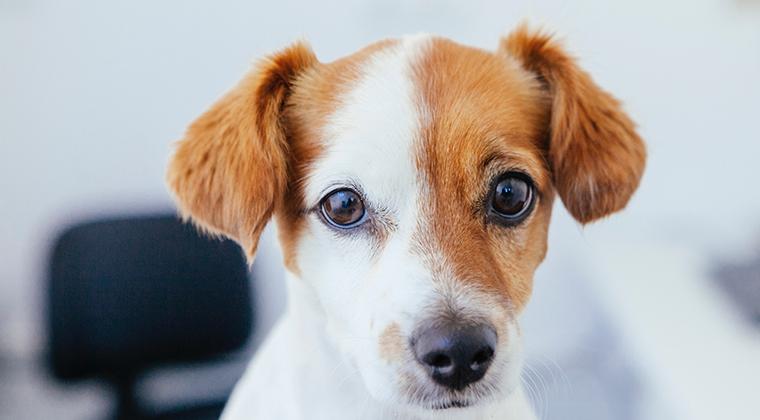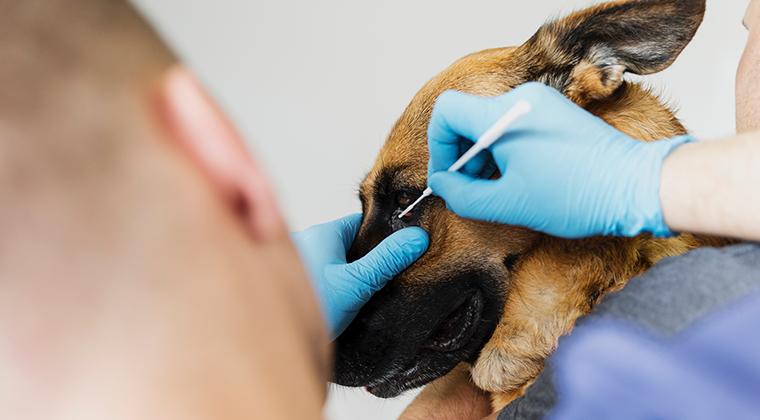Dogs: Eye Problems
If you look into your dog’s expressive eyes, you will see many emotions. If, unfortunately, your dog developed eye problems, he or she would not be able to communicate with you as well and could even lose his/her sight. Early detection and treatment may result in a good outcome.

Dogs’ eye structure
If you have some knowledge of the structure of your dog’s eyes, it may help you to recognise eye problems.
- A dog’s eyes are globe-shaped. There are two chambers, front and back, which are filled with fluid.
- A lens, which focuses light rays onto the retina at the back of the eye, separates the two chambers.
- The outer, transparent surface, which protects the eye, is the cornea.
- Dogs’ eyes have pupils and coloured irises, like us, with muscles for movement and opening and closing the lens to adjust the amount of light entering the eye.
- Dogs have an upper and lower eyelid and a third eyelid, called the nictitating membrane. It is found between the lower eyelid and the eye, at the lower, inner corner of the eye. It protects the eye and helps to remove foreign bodies.
- A gland in the third eyelid probably produces 30% of the aqueous component of the tear film.
- If there is a problem, the third eyelid may become enlarged.
- Look at your dog’s eyes carefully so that you know the structure and also the position of the third eyelid.
Cherry Eye
If you see a red, swollen lump in your dog’s lower inner rim of the eye, it is a condition called ‘cherry eye’, which affects the third eyelid. The gland in the third eyelid thickens and comes out of its usual place.
If your dog is recovering from anaesthesia or even when he is sleeping, you may be able to see his third eyelid. The red swelling, which may occur in both or one eye, is usually the first symptom of this disease. Some dogs’ eyes may look as if they have conjunctivitis (congestion/redenning), and some may have no other signs. It is seen most often in dogs between 6 months and 2 years.
The cause of cherry eye is unknown, so it cannot be prevented. However, a genetic predisposition may be the cause. If you see the signs you should take your dog to the vet quickly.
Your vet may prescribe eye drops, but if the swelling does not go down and your dog is uncomfortable, eventually surgery may be required.
Conjunctivitis, or “Pink Eye”
The conjunctiva sometimes gets inflamed, and your dog will have swelling of the tissue round the cornea, redness of the eye, a discharge and some discomfort. The dog may keep his/her eyes closed and rub them.
The causes of conjunctivitis include injury, tear duct problems, allergies, foreign matter, distemper, dry eye and sometimes tumours. Your vet will need to find out the cause of conjunctivitis before she can treat it and depending on what is causing the inflammation, may choose any of the following treatments:
- Antibiotics and saline solution to clear any infection
- Removal of the foreign body and painkillers
- For allergies, medication will be prescribed
- Medicated drops and moisturizing eye drops
Epiphora or Excess Tearing
Symptoms may include teary, watery eyes, with stained or smelly hair below the eyes. Many conditions involving profuse tearing or restricted drainage of tears, like conjunctivitis, corneal ulcers and abnormal eyelashes, can cause epiphora. The most common cause is inadequate draining of tears. Toy and miniature breeds seem to be more susceptible.
Another possible cause is if the dog’s eyelids turn inwards, which can affect the tear drainage system. The vet will find out the cause of the epiphora and treat accordingly. Sometimes surgery is an option to correct an eyelid’s position or to correct tear drainage.

Keratoconjunctivitis Sicca, or Dry Eye
Dry eye can look like a persistent infection or recurrent conjunctivitis. Often the dog has a mucus-like discharge from the eyes. He may also have clouding of the cornea, sometimes with ulcers. The cause of this is the lack of sufficient tears to lubricate the eyes, often because the dog’s immune system attacks the tear glands.
It is diagnosed by a tear-measuring strip test, which is simple and painless for the dog. The vet will then prescribe medication to improve tear production. Antibiotics, ointment and artificial tears may be prescribed.
Glaucoma
When there is a build-up of fluid, or aqueous humor, in the eye, caused by an imbalance of drainage and production of this fluid, it increases eye pressure which can be painful, with eye redness and loss of sight.
Symptoms include: dilated pupils, eye redness and dilation of the blood vessels in the white of the eye. One or both eyes may bulge, and your dog may rub at his/her eyes or keep them closed. He/she may appear lethargic, stop eating or be unresponsive – all may be due to the pain.
If your dog displays any of these signs, you should immediately take him to a vet. An instrument called a tonometer, which measures pressure in the eyes, is used to diagnose glaucoma. The vet will prescribe medical or surgical treatment.

Cataracts
The lens becomes cloudy (opaque) and light cannot get through to the retina, causing sight loss ranging in severity from mild to total vision loss. Some young dogs may have small lens imperfections and older dogs may have the normal thickening and/or hardening (sclerosis) of the lens which occurs in older animals. These conditions are not cataracts.
There are many causes of cataracts, which include: genetics (some breeds seem to be more susceptible than others), diabetes, inflammation, radiation, malnutrition and injury. Most diabetic dogs develop cataracts, caused by glucose degradation products attaching to lens proteins.
Cataracts do not necessarily mean that your dog will go blind. Vision may not be completely blocked, and dogs depend so much on their sense of hearing and smell, that vision loss may not be so serious for them. Most dogs cope well without treatment for their cataracts. The type of cataract, the breed of dog and many other factors influence whether the cataract remains as it is or grows.
Cataracts can be removed surgically by veterinary opthalmologists. Your vet will advise you regarding your dog’s condition and possible treatment options.
Look for signs like rubbing his/her eyes or face on the floor, which suggest that your dog has eye problems. If you are prompt at consulting your vet as soon as you see any signs of eye problems, in the case of glaucoma, this could save your dog’s sight.
ZA-NON-210900014
Subscribe to our Newsletter
Get to know your furry friend better! Sign up for all things dog- or cat-related.
The Hairy Facts about the dreaded hairball
12 April 2021
Help! My dog’s barking mad! Volume 2
12 April 2021
Your Itchy, Scratchy Cat – All About Cat Skin Problems
12 April 2021
The Dog’s Diet: A Bone of contention?
01 April 2021
Mango Fly Worms: How to Spot and Eliminate them
Posted on November 28,2019
Managing Mange And Mites In Your Dog
Posted on June 11,2018
Why Do Cats Purr and How? Learn What Your Cat Is Saying
Posted on October 14,2020
How to Get Rid of Ear Mites in Dogs
Posted on November 06,2019









